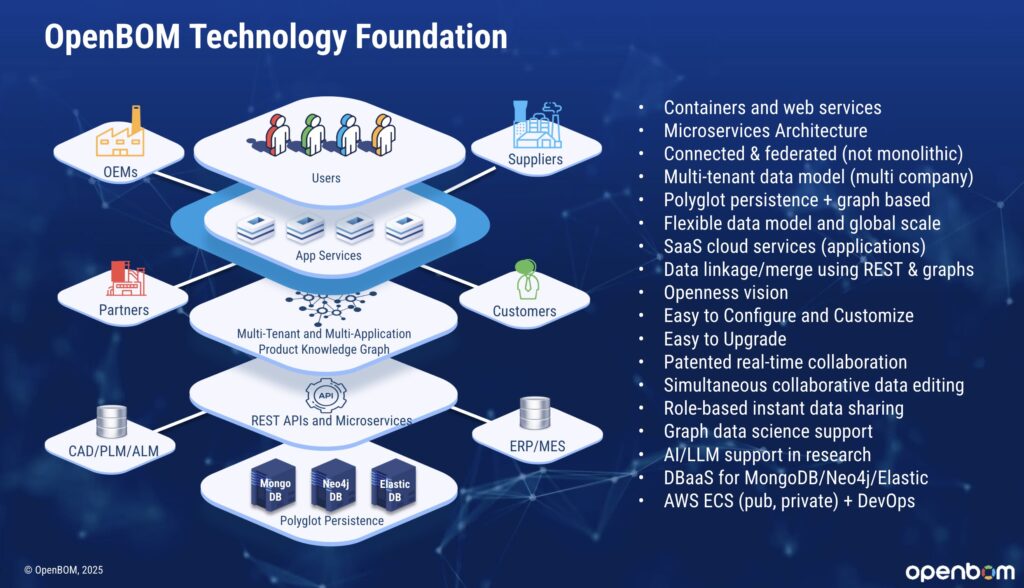
Digital transformation is a priority for manufacturing businesses looking at how to transform their processes from old-fashioned document-oriented processes to modern digital data-drive connected experiences. Product Lifecycle Management (PLM) is a business strategy and software foundation to help manufacturing companies manage information and product lifecycle through the overall journey from an initial set of requirements to engineering, manufacturing, sales, and maintenance stages.
The primary business goal of PLM is clear: to effectively organize and manage product information throughout their entire lifecycle, ensuring efficiency, quality, and competitiveness. Designing and building products requires the creation of efficient data management tools to model an entire product life cycle and build a product value chain. However, achieving this important goal requires more than just traditional data management.
The reality of all manufacturing companies these days is siloed information that resides in multiple enterprise systems – PLM, ERP, CRM, MES, and other databases and tons of Excel and legacy files. At the same time, the goal of PLM strategy is to establish a continuous and connected digital thread that weaves through various systems, forming a connected set of information. This interconnected web spans across all enterprise systems (PLM, ERP, CRM, MES), and other vital components of an organization’s technological ecosystem.
Pulling information into a consistent product data model can play an essential role in the successful implementation of digital thread to optimize operations in modern manufacturing enterprises.
In this article, I’d like to speak about how OpenBOM vision and technology to organize information and connect multiple applications and data by establishing a digital thread product model and building a product knowledge graph.
PLM’s Ambitious Data Management Goals
PLM’s holy grail is to organize data about the product and its lifecycle. The first vision of PLM software (organization of single source of truth SSOT) was to bring all information together into a single database. While the vision of PLM was great, the realization of PLM using a single relational database (RDB) had many limitations. Although, existing mature PLM systems successfully serve companies with management of product lifecycle and mostly focus on engineering and product development process, when it comes to an overall product organization, 25-30 years old PLM architecture shows signs of limitations in both data descriptiveness and ability to connect and navigates large models of information, connecting various “dots” of product data. Achieving PLM’s ambitious goals requires a dynamic and interconnected digital infrastructure that can seamlessly handle data across different systems. This infrastructure comes in the way of the digital thread.
The Importance of a Digital Thread
To achieve success in a modern PLM implementations, companies must establish a continuous and connected digital thread of information that links data residing in multiple systems, including PLM, ERP, CRM, MES, and more. This digital thread serves as the lifeline of product information, ensuring that data is connected between multiple applications as well as flows smoothly from one stage of the product lifecycle to the next. Without it, companies may find themselves struggling with disjointed product data management, inefficient processes, and costly errors.
Building a Robust Product Model
Creating a robust and scalable product model capable of aggregating information from various silos and linking it across multiple applications and companies is essential for building a digital thread. OpenBOM’s Product Knowledge Graph (PKG) emerges as a powerful model for constructing this digital thread, connecting applications and companies seamlessly.
Polyglot Persistence Data Architecture
OpenBOM adopts a modern approach to data management through its polyglot persistence data architecture. This architecture leverages a “graph object model” and employs multiple databases to scale effectively within large organizations and operate efficiently in multi-tenant environments. By doing so, OpenBOM ensures that its product data model is not only robust but also flexible enough to adapt to the unique needs of each customer.

The Role of Neo4j and Graph Databases
One of the cornerstones of OpenBOM’s product knowledge graph is the utilization of graph database (Neo4j). Graph databases excel at managing complex relationships between data entities, making them an ideal choice for constructing a comprehensive digital thread. By combining Neo4j with other databases, OpenBOM achieves polyglot persistence, enabling data to be stored and accessed in various ways, depending on the specific use case. Moreover, reliance on native graph data model allows to OpenBOM to perform various product structure and impact analysis queries x100s of time more efficient that traditional RDB.
Machine Navigability and Readability
OpenBOM’s vision goes beyond just managing data; it is committed to making all product information machine-navigable and machine-readable. This capability empowers organizations to leverage advanced technologies, such as artificial intelligence, to gain deeper insights, make more informed decisions, and eventually develop AI services to automate repetitive tasks (generate BOM) and validate information (check BOM for missing parts). The result is to increase the efficiency of existing processes and focus on the effectiveness of decision-making.
Conclusion
OpenBOM’s dedication to building a Product Knowledge Graph and a digital thread product model represents a vision of gathering product information and linking multiple systems to establish a consistent, machine readable, and machine navigable data set. It is a significant leap forward compared to old RDB-based object modelers. The efficiency of graph database with new graph data model and efficient queries capable of outperforming traditional RDB model is a foundation of new PLM data architecture. By embracing a graph object model, modern polyglot persistence data architecture, and the power of Neo4j and other databases, OpenBOM is paving the way for more efficient and connected product management.
The ultimate vision of OpenBOM is to establish the Product Knowledge Graph and digital thread product model as the foundation for PLM in every manufacturing organization. By doing so, OpenBOM aims to empower companies with the tools and insights needed to thrive in an increasingly competitive and fast-paced manufacturing landscape. With OpenBOM’s innovative approach, the future of PLM looks brighter than ever.
REGISTER FOR FREE and check how OpenBOM can help you today.
Best, Oleg
Join our newsletter to receive a weekly portion of news, articles, and tips about OpenBOM and our community.











